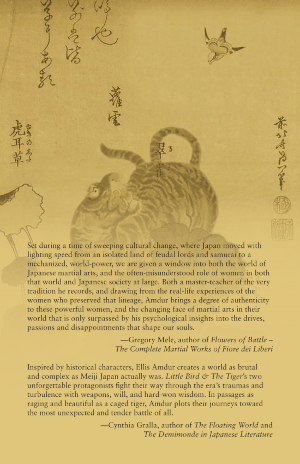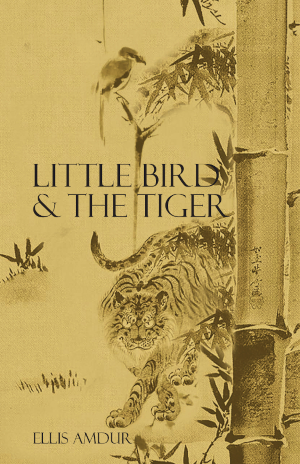Sample chapters REVIEW EXCERPTS
 Little Bird and the Tiger is embedded within Japan’s transition to modernity, it’s outburst into Asia, much like America’s contemporaneous ‘manifest destiny.’ This explosion of an insular culture into the wider world, whatever the cost, is encapsulated in the stories of Tachibana Hideo and Umezawa Tozaburo. Tachibana, an orphaned young woman who discovers martial arts as a child, wanders from dojo to dojo, both to perfect her art and to secure some food and shelter for the night. Becoming a consummate warrior in a society that denies women an independent life, she is nicknamed “Little Bird.” Under their breath, however, men refer to her as a ‘Shrike,’ a ferocious carnivorous bird.
Little Bird and the Tiger is embedded within Japan’s transition to modernity, it’s outburst into Asia, much like America’s contemporaneous ‘manifest destiny.’ This explosion of an insular culture into the wider world, whatever the cost, is encapsulated in the stories of Tachibana Hideo and Umezawa Tozaburo. Tachibana, an orphaned young woman who discovers martial arts as a child, wanders from dojo to dojo, both to perfect her art and to secure some food and shelter for the night. Becoming a consummate warrior in a society that denies women an independent life, she is nicknamed “Little Bird.” Under their breath, however, men refer to her as a ‘Shrike,’ a ferocious carnivorous bird.
Umezawa is one of those tragic young men who marches off to serve a cause he does not understand at the behest of men who use that bravery to their own ends. He becomes one of many Japanese adventurers who wandered Northeast Asia, joining local bandit gangs, involving themselves in revolutionary organizations, and most importantly, serving as spies to gather information on the countries that Japan intended to eventually conquer. His wanderings take him into the Primoye, the Maritime Provinces of Russia, joining the Nani (tribal people), then Khunkuz (Chinese bandits), then political terrorists in Korea and finally a return to Japan, careening from one locale to another like a wounded tiger, a path of violence and heartbreak.
 For these people (and many others in the book), violence is a language, a “physical dialogue,” with devastating consequences, win or lose. Within all these themes is interwoven that of love, both redemptive and tragic.
For these people (and many others in the book), violence is a language, a “physical dialogue,” with devastating consequences, win or lose. Within all these themes is interwoven that of love, both redemptive and tragic.
Set during a time of sweeping cultural change, where Japan moved with lighting speed from an isolated land of feudal lords and samurai to a mechanized, world-power, we are given a window into both the world of Japanese martial arts, and the often-misunderstood role of women in both that world and Japanese society at large. Both a master-teacher of the very tradition he records, and drawing from the real-life experiences of the women who preserved that lineage, Amdur brings a degree of authenticity to these powerful women, and the changing face of martial arts in their world that is only surpassed by his psychological insights into the drives, passions and disappointments that shape our souls.
—Gregory Mele, author of Flowers of Battle – The Complete Martial Works of Fiore dei Liberi
Inspired by historical characters, Ellis Amdur creates a world as brutal and complex as Meiji Japan actually was. Little Bird & The Tiger’s two unforgettable protagonists fight their way through the era’s traumas and turbulence with weapons, will, and hard-won wisdom. In passages as raging and beautiful as a caged tiger, Amdur plots their journeys toward the most unexpected and tender battle of all.
—Cynthia Gralla, author of The Floating World and The Demimonde in Japanese Literature
Those outside of the USA can purchase eBooks and bound books with local postage on their country’s Amazon site.

